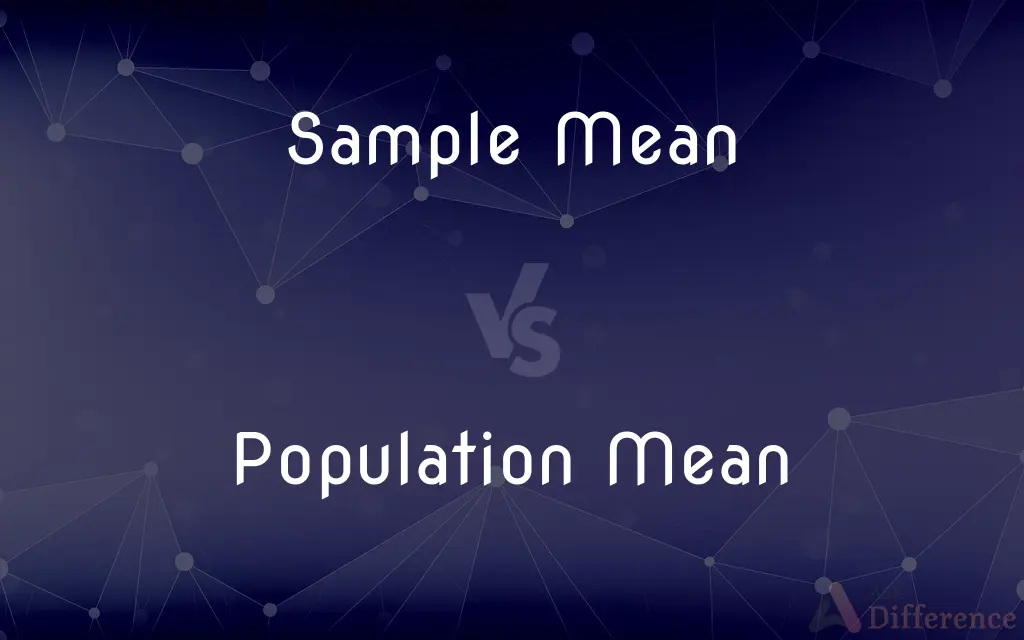Sample Mean vs. Population Mean — What's the Difference?
By Tayyaba Rehman & Fiza Rafique — Published on October 4, 2023
Sample Mean is the average of a subset of values, while Population Mean is the average of an entire group's values.

Difference Between Sample Mean and Population Mean
Table of Contents
ADVERTISEMENT
Key Differences
The Sample Mean, as its name suggests, pertains to a sample, which is a subset of a larger group. It's an estimate that provides information about a particular section of the population. The Population Mean, conversely, encompasses the entire set of individuals or items of interest. It represents the true average of the entire group without exclusion.
Both Sample Mean and Population Mean serve pivotal roles in statistical analyses. While the Sample Mean is used when it's impractical or impossible to study an entire population, the Population Mean is ideal when all data is accessible. They differ fundamentally in their scope of representation.
It's important to note that the Sample Mean may not always accurately represent the Population Mean, given the potential for sampling errors or biases. In situations where sampling errors occur, there may be discrepancies between the two. However, the Population Mean remains static as it accounts for all values in the population.
Understanding the distinction between Sample Mean and Population Mean is critical, especially when interpreting statistical results. While a well-selected sample can offer a good approximation of the Population Mean, it's always a mere estimation, leaving room for potential error.
Comparison Chart
Scope
Subset of the population
Entire population
ADVERTISEMENT
Representation
Approximation of the true average
True average
Reliability
Subject to sampling error
Not subject to sampling error
Usage
When studying a portion of the population
When all data from the population is available
Variability
May vary across different samples
Remains constant for a given population
Compare with Definitions
Sample Mean
The central tendency of a subset of values.
The Sample Mean age of participants was 30 years.
Population Mean
Overall average without excluding any data points.
The Population Mean age in the community is 35 years.
Sample Mean
Sum of sampled values divided by the number of samples.
The Sample Mean of daily temperatures in July was 78°F.
Population Mean
True average derived from every member of a set.
The Population Mean height for adult males in the country is 5'9.
Sample Mean
Statistical estimate of a population's average based on a sample.
The Sample Mean weight from the study was 150 lbs.
Population Mean
Central value representing an entire data set.
The Population Mean annual rainfall in the region is 60 inches.
Sample Mean
Average of selected data points from a larger set.
The Sample Mean of students' test scores from Class A is 85.
Population Mean
Sum of all values in a population divided by its size.
The Population Mean income for the city is $60,000.
Sample Mean
A representative value derived from a portion of the population.
Based on our survey, the Sample Mean income was $50,000.
Population Mean
The average of all values in a defined group.
The Population Mean score for all students in the district is 80.
Common Curiosities
Can there be multiple Sample Means for the same population?
Yes, different samples from the same population can produce different Sample Means.
Is the Population Mean more accurate than the Sample Mean?
Yes, the Population Mean represents the true average of the entire group.
Why might one use the Sample Mean over the Population Mean?
Studying an entire population might be impractical or impossible, so the Sample Mean serves as an estimate.
Can the Population Mean change?
Yes, if the values within the population change, the Population Mean will adjust accordingly.
Is the Sample Mean always close to the Population Mean?
Not necessarily. While a well-selected sample can approximate the Population Mean, sampling errors can occur.
Why is the Population Mean considered the "true average"?
Because it includes all values in a given set, not just a subset.
Is the Sample Mean always derived from a smaller group than the Population Mean?
Yes, the Sample Mean comes from a subset, while the Population Mean encompasses the entire group.
In which scenarios is the Population Mean typically used?
When data for the entire group is available and can be feasibly analyzed.
How are both the Sample Mean and Population Mean calculated?
By summing the values and dividing by the number of values. Sample uses subset values; population uses all values.
Are both values affected by outliers?
Yes, both the Sample Mean and Population Mean can be influenced by extreme values.
How do statisticians ensure the Sample Mean approximates the Population Mean?
They aim for random sampling and sufficient sample sizes to reduce potential errors.
What happens if the Sample Mean greatly differs from the Population Mean?
This suggests potential sampling error, bias, or that the sample isn't representative of the population.
Can a study have multiple Sample Means but only one Population Mean?
Yes, multiple samples can be taken from one population, each with its own Sample Mean, but the population will have a single Population Mean.
Do both the Sample Mean and Population Mean always refer to numeric data?
Typically, yes. They represent averages and are derived from quantitative data.
Which is more susceptible to fluctuations: Sample Mean or Population Mean?
The Sample Mean, as different samples can yield different results.
Share Your Discovery

Previous Comparison
Blinking vs. Flickering
Next Comparison
True Variable Cost vs. Step Variable CostAuthor Spotlight
Written by
Tayyaba RehmanTayyaba Rehman is a distinguished writer, currently serving as a primary contributor to askdifference.com. As a researcher in semantics and etymology, Tayyaba's passion for the complexity of languages and their distinctions has found a perfect home on the platform. Tayyaba delves into the intricacies of language, distinguishing between commonly confused words and phrases, thereby providing clarity for readers worldwide.
Co-written by
Fiza RafiqueFiza Rafique is a skilled content writer at AskDifference.com, where she meticulously refines and enhances written pieces. Drawing from her vast editorial expertise, Fiza ensures clarity, accuracy, and precision in every article. Passionate about language, she continually seeks to elevate the quality of content for readers worldwide.












































